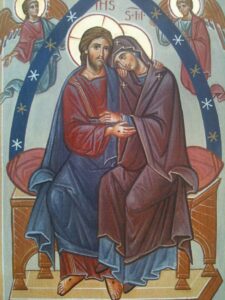Recently ordained priests–like all priests–are priests because the bishop–and all the members of the presbyterate–laid hands on them, thus leaving them “fit into the body of bishops,”[1] made into “successors of the Apostles in the priesthood” through the power to “consecrate, offer, and administer the Body and Blood of the Lord.”[2]
The laying on of hands was not a mere gesture of blessing, as when Jesus blessed the children: Then he embraced them and blessed them, placing his hands on them (Mk 10:16).
Nor does this laying of hands deal with curing sickness: He stretched out his hand, touched him, and said, “I will do it. Be made clean.” His leprosy was cleansed immediately (Mt 8:3).
Nor does it implore divine assistance: Then, completing their fasting and prayer, they laid hands on them and sent them off (Acts 13:3).
Nor is it the transmission of the Spirit in the Sacrament of Confirmation: Then they laid hands on them and they received the Holy Spirit (Acts 8:17).
This is not the imposition of hands over the offerings, as is done at Mass, in order to determine the matter of the sacrifice by a sign of appropriation.
We are priests because the laying on of hands was in order to communicate an office or power:
- For the service of tables: They presented these men to the apostles who prayed and laid hands on them (Acts 6:1-6).
- For preaching: Now Stephen, filled with grace and power, was working great wonders and signs among the people. Certain members of the socalled Synagogue of Freedmen, Cyrenians, and Alexandrians, and people from Cilicia and Asia, came forward and debated with Stephen, but they could not withstand the wisdom and the spirit with which he spoke (Acts 6:810).
- For governing the community: Paul to Timothy. . . . For this reason, I remind you to stir into flame the gift of God that you have through the imposition of my hands (2 Tim 1:6).
- In order to constitute the recipient as a leader of the Church with the capacity to lay his hands on others: Do not lay hands too readily on anyone (1 Tim 5:22). The laying on of hands is a religious rite carried out in order to bring someone into the hierarchy: They appointed presbyters for them in each church and, with prayer and fasting, commended them to the Lord in whom they had put their faith (Acts 14:23); that is, it is in order to introduce them into the Episcopal College, in their level.
Human hands are laid on the candidate, “but the whole work is of God,” said Saint John Chrysostom, “and it is His hand which touches the head of the one ordained.”[3]
Around the year 215, Saint Hippolytus of Rome was already teaching why the priests, and not only the bishop, lay hands for ordination to the priesthood: it is “by reason of the common and similar spirit of their office.” The contrary is true for the deacon, on whom “only the bishop imposes hands, because he is not or dained to the priesthood, but rather to the service of the Bishop and to do that which he orders.”[4]
We are priests because we have received the imposition of hands, and we received it in a particular and local Church, in a particular diocese. How can we know if this Church is the real Church? In order to know if it is the real one, these criteria must be met: being of one mind regarding doctrine, having received this doctrine and the munus by means of apostolic succession, and maintaining communion with Rome.
This is what the Holy Fathers maintained: for Saint Irenaeus, Christ has summed up all things in Himself, and, in virtue of this summary, God has made Him head of all the Church, taking upon Himself all primacy.[5] This universal Church is disseminated throughout the entire world, and yet is “only one house.”[6] The two criteria to determine if a particular Church is united with “the very great, the very ancient, and universally known Church founded and organized at Rome by the . . . apostles Peter and Paul”[7] is to examine if it is of one mind in the faith received from the Apostles,[8] which is the baptismal creed, received by means of baptism,[9] and if it possesses uninterrupted Apostolic succession: “together with the succession of the episcopate, they have received the certain gift of truth.”[10] These two characteristics permit us to be certain of the authenticity of our local Church, and to distinguish it from those of heretics. Moreover, these are the criteria that lead us “to obey the presbyters who are in the Church,” as they “possess the succession from the apostles,”[11] and, with that succession, they have received the gift of truth.
[1]Ecumenical Second Vatican Council, Dogmatic Constitution on the Church, Lumen Genti-um, 28.
[2] DS 1764.
[3] Saint John Chrysostom, In Act. Hom., 14, n. 3: PG 60, 116; R1214.
[4] Tradit. Apost., 8.
[5] Cfr. Adv. Haereses, 3, 16, 6.
[6] Ibid., 1, 10, 1.
[7] Ibid., 3, 3, 2.
[8] Ibid., 1, 10, 1-2.
[9] Ibid., 1, 9, 4.
[10] Ibid., 4, 26, 2.
[11] Ibid., 4, 26, 2.







